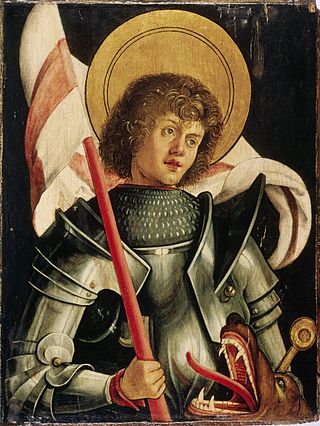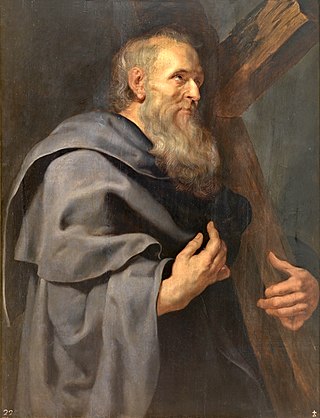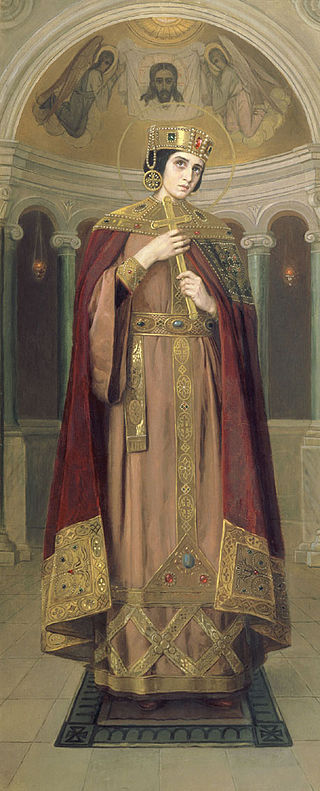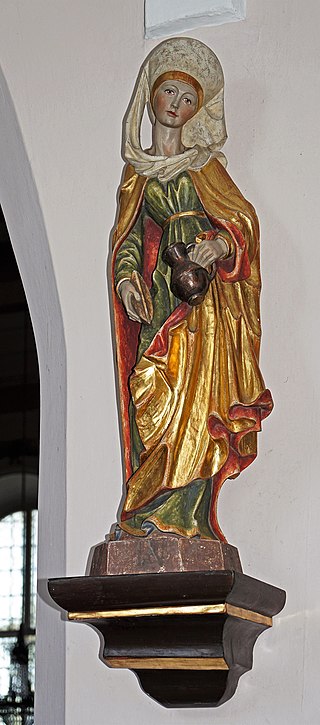Related Research Articles

Saint George, also George of Lydda, was a Christian who is venerated as a saint in Christianity. According to tradition he was a soldier in the Roman army. He was of Cappadocian Greek origin and a member of the Praetorian Guard for Roman emperor Diocletian, but was sentenced to death for refusing to recant his Christian faith. He became one of the most venerated saints and megalomartyrs in Christianity, and he has been especially venerated as a military saint since the Crusades. He is respected by Christians, Druze, as well as some Muslims as a martyr of monotheistic faith.
Pope Fabian was the bishop of Rome from 10 January 236 until his death on 20 January 250, succeeding Anterus. A dove is said to have descended on his head to mark him as the Holy Spirit's unexpected choice to become the next pope. He was succeeded by Cornelius.

Philip the Apostle was one of the Twelve Apostles of Jesus according to the New Testament. Later Christian traditions describe Philip as the apostle who preached in Greece, Syria, and Phrygia.

Blaise of Sebaste was a physician and bishop of Sebastea in historical Armenia who is venerated as a Christian saint and martyr.

February 10 - Eastern Orthodox liturgical calendar - February 12

June 24 - Eastern Orthodox Church calendar - June 26

August 3 - Eastern Orthodox liturgical calendar - August 5
Cyricus, and his mother, Julitta are venerated as early Christian martyrs. According to tradition, they were put to death at Tarsus in AD 304.

Saint Juliana of Nicomedia is said to have suffered Christian martyrdom during the Diocletianic persecution in 304. She was popular in the Middle Ages, especially in the Netherlands, as the patron saint of sickness.

Menas of Egypt, a martyr and wonder-worker, is one of the most well-known Coptic saints in the East and the West, due to the many miracles that are attributed to his intercession and prayers. Menas was a Coptic soldier in the Roman army martyred because he refused to recant his Christian faith. The common date of his commemoration is November 11, which occurs 13 days later on the Julian calendar.

Saint Alexandra of Rome (Ἀλεξάνδρα) — Christian martyr and saint, known from "Martyrdom of Saint George" as either Emperor Diocletian's wife or the wife of Dacian, a Roman Prefect. She is also sometimes mistaken with Priscilla or Prisca.

Saints Cyrus and John are venerated as martyrs. They are especially venerated by the Coptic Church and surnamed Wonderworking Unmercenaries because they healed the sick free of charge.

Saints Victor and Corona are two Christian martyrs. Victor was a Roman soldier who was tortured and killed; Corona was killed for comforting him. Corona is invoked as a patron of causes involving money; she was not historically associated with pandemics or disease, but has been invoked against the coronavirus pandemic.
Abāmūn of Tarnūt is a saint and was a martyr of the fourth-century Coptic Church. He is known only from his name being mentioned in the Synaxarion of Mikhail of Atrib (c.1240). His feast day is 3 August.

Christina of Bolsena, also known as Christine of Bolsena, or in the Eastern Orthodox Church as Christina the Great martyr, is venerated as a virgin martyr of the third century. Archaeological excavations of an underground cemetery constructed over her tomb have shown that she was venerated at Bolsena by the fourth century.

Saint Demiana and the 40 Virgins was a Coptic martyr of the early fourth century.

Verena of Zurzach, mostly just called Saint Verena is an early Christian consecrated virgin and hermit. She is especially venerated in Switzerland, where her cult is attested in Bad Zurzach, the reported place of her burial, from at least the 5th century. She is recognized as a saint in the Roman Catholic Church as well as in the Eastern Orthodox Church and the Oriental Orthodox Churches. Her feast is on 1 September.

December 4 - Eastern Orthodox liturgical calendar - December 6

December 9 - Eastern Orthodox liturgical calendar - December 11
Saint Arianus was a historically attested governor of Ansena in Egypt and a notable figure in the Diocletianic persecution. He is a recurring character in Coptic hagiography, wherein he often attempts to torture Christian martyrs into worshiping idols, gets frustrated with their resilience and has them beheaded. In these hagiographies he is depicted with a sadistic fondness for torture, employing various methods such as beating, combing, nailing, burning, imprisoning, crucifying, and spearing Christians.
References
- ↑ "Card". Oxford English Dictionary. Oxford University Press. 2nd edition. 1989.
- 1 2 Herodotus, The Histories, Book 1, Ch. 92. Translation of Robin Waterfield. "And when Croesus had gained possession of the kingdom by the gift of his father, he put to death the man who opposed him, drawing him upon the carding-comb". Herodotus, I.92.
- 1 2 Talmud, Berachot 61b
- ↑ "What's behind the most famous Jewish prayer?" (Aish HaTorah, Jerusalem, Israel)
- ↑ The Times between Constantine and Theodosius the Great: Arianist Emperors and Julian the Apostate
- ↑ E.-H. Vollet, in the Grande Encyclopédie s.v. Blaise (Saint))
- ↑ Life in Yorkshire
- ↑ ""A History of St Blaise ", St Blaise Town Council". Archived from the original on 2009-02-16. Retrieved 2009-03-20.
- 1 2 "Lives of the Saints" (maintained by St. Mark Coptic Church, Jersey City, NJ)
- ↑ "The Martyrdom of Saint Febronia the Ascetic", St. Mary & St. Antonios Coptic Orthodox Church, Ridgewood, NY Archived 2010-06-13 at the Wayback Machine